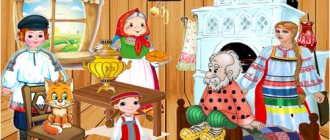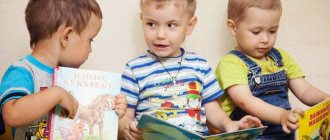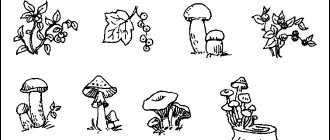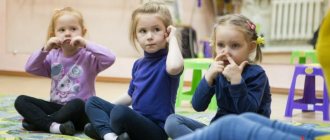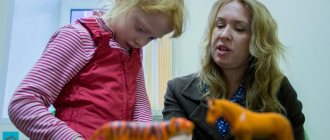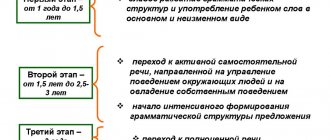Card index of didactic games for speech development.
“Create an advertisement for a book (dress, etc.)”
Target:
Develop the ability to creatively use words, the ability to figuratively describe an object, to give it a vivid description.
Progress of the game:
The child must talk about the subject briefly, clearly, paying attention to characteristic details.
"Seller and Buyer"
Target:
To develop in children the ability to construct sentences with attribute words.
Material:
Objects (pictures depicting objects) similar in purpose, but different in appearance.
Progress of the game:
On a table or shelf or easel there are several objects that are similar in purpose but different in appearance (pictures depicting these objects). The child must describe the item in such a way that the “seller” understands what item we are talking about. The name of the item may not be mentioned. Let other children also guess what we are talking about.
“Describe-guess”
Target:
To develop the ability to compose short stories of a creative nature on a topic proposed by the teacher. Develop a monologue form of speech.
Progress of the game:
The child must describe the appearance of the other child, and the other children must name who their friend was talking about.
“Describe the toy”
Target:
To develop in children the ability to construct sentences with words-objects, words-attributes, words-actions.
Material:
Animal toys.
Progress of the game:
Gradually, the exercises can be complicated by adding new features of objects and expanding them.
You should put several animal toys in front of the child and describe them.
The fox is an animal that lives in the forest. The fox has red fur and a long tail. She eats other small animals.
A hare is a small animal that jumps. He loves carrots. The hare has long ears and a very small tail.
"Magic bag" ("Black box")
Target:
Develop imagination, the ability to talk about the characteristic properties of the objects being described, their purpose, the materials from which they are made, and determine the thematic group to which the objects belong.
Material:
Box with an item.
Progress of the game:
An object is placed in a bag or box (a picture can be used).
Children gradually determine what is in the bag (box) by asking questions about certain properties and characteristics of objects: “Is this a toy? Is it wooden? Is it plastic? Can she be rolled? Etc.".
"Guess it"
Target:
Teach children to describe an object without looking at it, to find significant features in it; recognize an object by description.
Progress of the game:
The teacher reminds the children how they talked about familiar objects, made and guessed riddles about them and suggests: “Let's play. Let the objects in our room tell us about themselves, and we will guess from the description which object is speaking. We must follow the rules of the game: when you talk about an object, don’t look at it so that we don’t guess right away. Talk only about the objects that are in the room.” After a short pause (children must choose an object to describe and prepare to answer), the teacher places a pebble on the lap of anyone playing. The child stands up and gives a description of the object, and then passes the pebble to the one who will guess. Having guessed, the child describes his object and passes the pebble to another player so that he can guess.
Speech “Game techniques for the development of speech creativity of preschool children”
Game techniques for the development of speech creativity in preschool children
Message from work experience. Teacher Kravchenko G.P.
Recently, there has been a tendency that adults
began to pay less attention to the development of children’s own speech. IN
As a result, the speech of older preschoolers is characterized by poor vocabulary
stock, weak expressiveness, poor diction. For the development of speech
creativity of children, it is necessary to work to increase the levels of speech
communication, coherent speech, vocabulary, grammatical structure of speech, the sound side of speech, practical awareness of the elements of language.
The creative development of a child is possible only with positive motivation. The most powerful motive for a child is play. It is the game that makes the process of completing tasks and solving problem situations interesting, exciting, and stimulating a creative approach. In our work with children on the development of speech creativity, we use
the following techniques.
First of all, these are verbal game exercises.
Verbal exercises can be carried out at various points in the pedagogical process. They can be used as part of a lesson, in entertainment, in free activities, on a walk, etc. Exercises “Pick a sign”, “Which one?” Which? Which? What?”, “What can we say autumn (autumn, autumn)?” They are taught to agree adjectives with nouns in a certain gender and number. To activate verbs in speech, we carry out exercises: “Who can name more actions?”, “Where, what can you do?”, synonyms “Say it differently,” antonyms “Say the opposite,” “Find the opposite word.” In order to teach how to correctly compose sentences, we use the following exercises: “Think of it yourself”, “Complete the sentence”, “I’ll start, and you finish”
We use the games “Guess it”, “Tell it”, “Find out by description” - they teach the description and comparison of objects, phenomena, events, etc.
To enrich children’s speech with epithets and comparisons, we often suggest answering questions like: “Is it as fluffy as what?” Children answer: “Like a cat, a bunny, a fox, snow, a fur coat, a hat, a scarf, fluff.” To the question: “As cheerful as...?” The answers were as follows: “Like a clown, like the boy Vova, like a photograph, like a fireworks display, like a rainbow, like a bunny, like the sun, like a cloud, like a family, like a mommy, like a monkey.”
Conversation games.
They are based on communication. Such a game makes demands on the activation of emotional and mental processes. It develops the ability to listen to questions and answers, focus on the content, supplement what is said, and express judgments. Cognitive material for this type of games should be given in an optimal volume, be accessible and understandable in order to arouse the interest of children. Cognitive material is determined by the lexical topic and the content of the game. The game, in turn, must correspond to the mental capabilities of children. A prerequisite is to conduct games after observations, examination, comparisons, and ethical conversations. The child must accurately represent the subject in question. “Imagine that you are a snowflake”, “If I were a spider”, “I am an autumn leaf”, “Do you know yourself?”, “I am a frog - Princess”.
Children are interested in games in which fairy tale characters act.
. Fairy-tale characters especially arouse interest and creative activity in children. To the question: “What Baba Yaga?” children answer with pleasure: “Scary, bone leg, long-nosed, forest, cunning, witch, cheerful.” It is interesting that children select adjectives that indicate different characteristics of the hero: character and behavior, place of residence.
Game "Telephone"
is carried out with the aim of strengthening the ability to identify the structural parts of a story or fairy tale and combine them into a single whole. Over the phone, the participants in the game will tell each other fairy tales. While telling a story, you can stop at any place and invite your interlocutor to continue. The teacher monitors the correctness of the retelling. If someone makes a mistake, the phone “breaks.” The game can be continued only when the children find out and eliminate the cause of the “breakdown”. Any number of children can take part in the game.
Games “Remember the nickname”, “Say the opposite” and “Name it beautifully”
help children comprehend the beauty and expressiveness of Russian speech, enrich their vocabulary. In the game “Remember the nickname”, the children remember what nicknames are given to animals in fairy tales (fox - sister, fox - red beauty, wolf - wolf - gray tail, bunny - runaway, bunny - coward). In the game “Name It Beautiful,” preschoolers select synonyms for the characteristics of fairy tale heroes (in the fairy tale “Zayushkina’s Hut,” the bunny is a coward, pathetic, weak; the fox is cunning, a deceiver, a cheat; the rooster is brave, daring). The game “Say the opposite” reinforces knowledge about antonyms, teaches you to concentrate (cowardly bunny - brave rooster, evil Koschey the Immortal - kind Ivan Tsarevich, hardworking stepdaughter - lazy daughter).
In the game "Guess the Fairy Tale"
The plot is reproduced using toys. The child independently selects the necessary toys and shows a scene from any fairy tale familiar to him. All other children must guess the fairy tale and tell what it is about. Subsequently, the rules of the game become more complicated. The child must come up with his own fairy tale or story and show scenes using toys.
Didactic content of the guessing game
lies in the fact that children are given a task and a situation is created that requires comprehension of the subsequent action. The game task is contained in the title itself: “What would happen if all the fairy-tale heroes began to live next to us?”, “Which of the fairy-tale heroes would you choose as your friend?”, “What would I do if...”, “Which of the fairy-tale heroes would you choose?” book heroes I would like to be and why?” and etc.
Phone games
“Calling a Doctor”, “Calling Mom at Work”, “Bureau of Good Offices” teach how to conduct a dialogue over the phone.
In our work on the development of speech creativity, we also use games with ready-made texts “I was born a gardener”, “Colors”, “Smeshinki”, etc. They encourage children to make contacts, are a motive for communicative activities, help to master a variety of initiative and response remarks, adhere to the implementation of the basic rules of dialogue. Didactic games that involve dialogic interaction, but do not contain ready-made remarks: “Who will confuse whom,” “Assignment,” “Alike - not alike,” encourage children to independently construct dialogic remarks.
Strengthening the ability to ask and answer questions is carried out in the games “Yes and No”, “Questions with a Hint”, “Forbidden Words”, “Tournament of Experts”. Participation in them requires from preschoolers an effort of thought, memory, activation of knowledge about objects, nature, etc.
For example, in the game
“Yes and no” children ask a chain of questions so that, receiving only “yes” and “no” in response, they can guess what is hidden in the magic chest. The accuracy of the questions depends on the clarity of the child’s understanding of the characteristics of objects or living beings, etc.
All our work is aimed at solving one of the most important tasks of speech development - trying to teach children to express their thoughts coherently, competently and consistently. Teach the ability to talk about what is happening around using a variety of speech means. All this is very important for the formation of personal qualities, and in the future for successful learning at school, positive communication with peers and adults.
We kindergarten teachers need to organize speech this way.
the child’s activity so that it is playful and entertaining in nature, because only in this way can the child develop the ability to accurately and figuratively express his thoughts and feelings in the spoken word. Then the result of the work will in the near future be the correct, stylistically and emotionally rich, beautiful speech of the child.
Types and examples of didactic games for preschoolers
Didactic games differ in content, actions, rules and come in three types:
- games with objects;
- printed board games;
- verbal didactic games.
Their degree of difficulty can be adjusted depending on the age of the participants. The same game can have several variants. For example, kids arrange cards by color; Older children name numbers; and someone can already put the word together.
Games with objects
1. Magic bag
You need to pull out objects of different shapes by touch from the bag: a ball, a cube, a pyramid. Or objects with different textures: pine cone, acorn, chestnut.
2. Rainbow
The child is invited to arrange cubes, mosaics, and pyramids by color.
During didactic games with objects, the child learns to think, analyze, compare objects with each other, he becomes more attentive, his horizons expand, and his fine motor skills improve.
Board-printed games
There is a huge scope for choosing what will be most interesting to your baby at a given time. It can be:
- Pictures for recognition in the form of images, shadows, contours.
- Puzzles.
- Lotto.
- Pictures: find the differences.
- Pictures: pick a pair.
- Labyrinths.
- Designers.
Such didactic games for preschoolers on speech development are interesting and educational. They successfully develop speech skills, logic and imagination, and develop perseverance and patience.
Word games
This type of cognitive communication is very relevant when there are no special objects at hand, so you can use the most familiar things. Here are some examples of such didactic games for the development of speech in preschoolers.
1. Doll
Description of the appearance: color of hair, eyes, clothing items of the fashionable doll.
2. Who is missing?
Place several soft toys nearby. Ask them to close their eyes and remove one. Who can guess: who is missing? We need to name it, tell it what it looks like, figure out where it ran away to.
3. Cube
They roll a dice with pictures on each side. You need to name what is depicted on the top edge and imitate the sound of the object. For example, a steam locomotive. How does the locomotive sound?
4. Catch the ball - name the word that has the opposite meaning. Hot-cold, big-small, close-far.
Verbal games for preschoolers develop speech, reaction speed, correct pronunciation of sounds, expand vocabulary, teach how to construct sentences correctly, and express their thoughts coherently.

